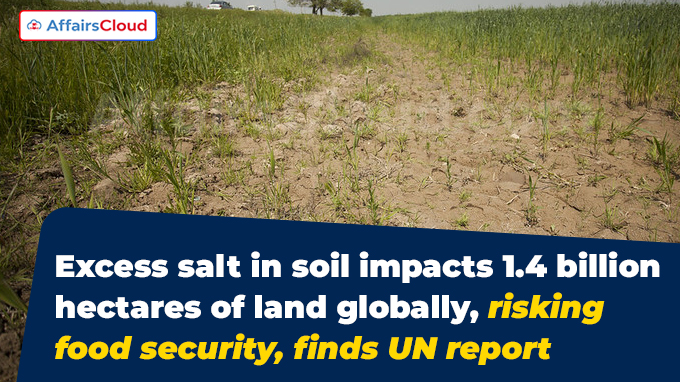 In December 2024, the Food and Agriculture Organization(FAO) of the United Nations (UN) released its first major global assessment of salt-affected soils in 50 years. The report, titled “The Global Status of Salt-Affected Soils” was launched during the International Soil and Water Forum 2024 in Bangkok, Thailand.
In December 2024, the Food and Agriculture Organization(FAO) of the United Nations (UN) released its first major global assessment of salt-affected soils in 50 years. The report, titled “The Global Status of Salt-Affected Soils” was launched during the International Soil and Water Forum 2024 in Bangkok, Thailand.
- According to the report, nearly 1.4 billion hectares (ha) of land or 10.7% of the global land area was affected by salinity.
- The report also highlights the increasing threat of soil salinity, urging global action to address soil degradation and water scarcity which impose serious risks to food security worldwide.
Note: Salt-affected soils refer to soils with high levels of soluble salts (saline soils) or exchangeable sodium (sodic soils), which hinder the growth of most plants.
Highlights of the Report:
Global Impact:
i.Around 10% of both irrigated and rain fed cropland is affected by salinity, putting significant pressure on food security.
- The area of salt-affected soils may rise to between 24% and 32% of the total land area as temperatures continue to increase due to climate change.
ii.Afghanistan, Australia, Argentina, China, Kazakhstan, Russia, the United States of America (USA), Iran, Sudan and Uzbekistan account for 70% of the world’s salt-affected soils.
Countries with largest Areas of Salt-Affected Soils:
The largest areas of countries that are affected with salinity includes:
- Australia (357 mha), Argentina (153 mha), Kazakhstan (94 mha), Russian Federation (77 mha), United States of America (USA) (73.4 mha), Islamic Republic of Iran (55.6 mha), Sudan (43.6 mha), Uzbekistan (40.9 mha), Afghanistan (38.2 mha) and China (36 mha).
Countries Most Affected by Salinity and Sodicity:
The countries that are most affected by salinity and sodicity includes:
- Oman (93.5%), Uzbekistan (92.9%), Jordan (90.6%), Kuwait (88.8%), Iraq (70.5%), United Arab Emirates (UAE) (60.5%), Afghanistan (58.6%), Argentina (56%), Australia (46.4%) and Eritrea (40.1%).
Salt-Affected Soils in India:
i.As per the report India had approximately 6.72 million hectares (mha) of salt-affected soils of which 2.95 mha were saline and the remaining 3.77 mha were sodic which constitute about 2.1% of the country’s total geographical area.
- The salt-affected area in India is divided into 2.95 mha of saline soils and 3.77 mha of sodic soils.
ii.The states of Gujarat (2.23 mha), Uttar Pradesh (UP) (1.37 mha), Maharashtra (0.61mha), West Bengal(WB)(0.44 mha) and Rajasthan (0.38 mha) account for about 75% of India’s salt-affected soils.
- In India, 20% of agricultural land is affected by salt or sodicity, with regions such as Jaisalmer (Rajasthan), the coastline of Gujarat and the Ganges Basin being the most impacted.
iii.Additionally, about 17% of the country’s irrigated agricultural land has been affected by secondary salinization due to the use of brackish irrigation water.
iv.Poor quality irrigation water, lack of adequate drainage, and canal irrigation schemes without proper drainage have contributed to salinization, particularly in areas like Rajasthan (0.18 mha) and UP (0.37 mha).
Drivers of Salinization:
Salinization is driven by both natural processes and human activities:
i.The climate crisis is increasing aridity and freshwater scarcity, while rising sea levels are projected to exacerbate flooding and salinization in coastal regions, affecting more than one billion people by the end of the century.
- Global warming is contributing to salinization through the thawing of permafrost.
ii.Human activities also play a significant role in exacerbating salinization including using poor quality irrigation water, inadequate drainage systems, deforestation, excessive groundwater extraction and overuse of fertilizers and chemicals.
Strategies for Managing Salt-Affected Soils:
The FAO report provides several strategies to manage salt affected soils effectively that includes:
- Mitigation: Techniques such as mulching, using interlayers of loose material, installing drainage systems, and improving crop rotations can help reduce the impact of salinization.
- Adaptation: Breeding salt-tolerant crops that can thrive in saline environments, such as mangrove swamps and tropical sand dunes, can help make agriculture more resilient to salt-affected soils.
- Bioremediation: Utilizing bacteria, fungi, plants, or animals to remove or neutralize harmful substances in the soil is another approach to mitigating salinization.
About International Soil and Water Forum 2024:
i.The International Soil and Water Forum 2024 was co-organized by the Food and Agriculture Organization of the United Nations (FAO) and the Ministry of Agriculture and Cooperatives of the Thailand Government to discuss an action plan for halting and reversing soil degradation and water scarcity.
ii.The forum was held from December 9 -11, 2024 in Bangkok, Thailand with 4 themes:
- Theme 1: Managing water scarcity.
- Theme 2: Reversing land degradation, boosting land restoration.
- Theme 3: Sustainable soil management.
- Theme 4: Integrated climate resilient land, soil and water management.
About the Food and Agriculture Organization(FAO):
Director-General(DG)– Qu Dongyu
Headquarters – Rome, Italy
Established – 1945




